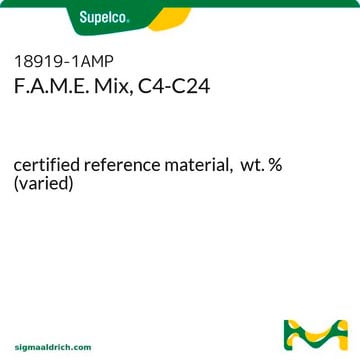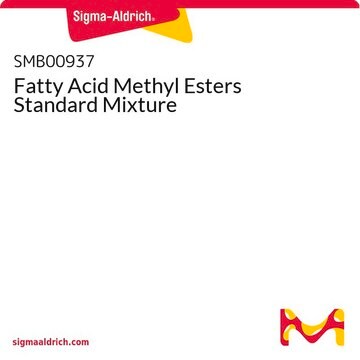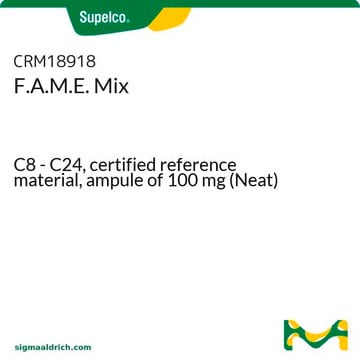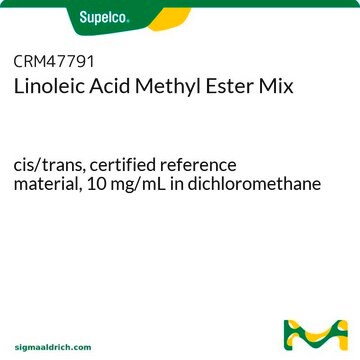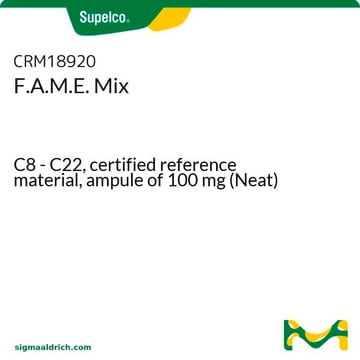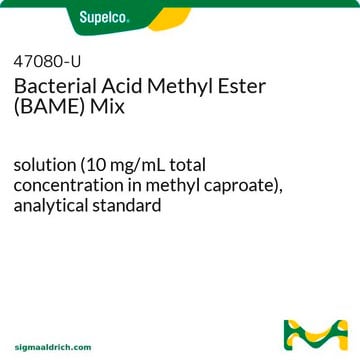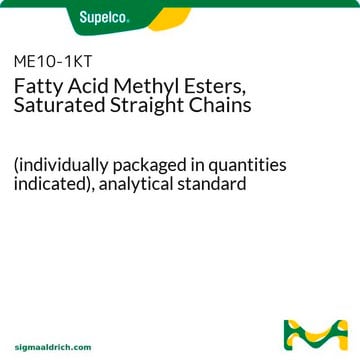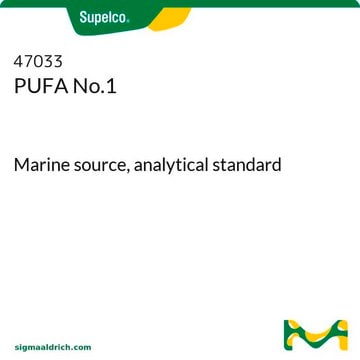Products may be shipped at a different temperature than the recommended long-term storage temperature. If the product quality is sensitive to short-term exposure to conditions other than the recommended long-term storage, it will be shipped on wet or dry-ice. If the product quality is NOT affected by short-term exposure to conditions other than the recommended long-term storage, it will be shipped at ambient temperature. As shipping routes are configured for minimum transit times, shipping at ambient temperature helps control shipping costs for our customers. For more information, please refer to the Storage and Transport Conditions document: https://www.sigmaaldrich.com/deepweb/assets/sigmaaldrich/marketing/global/documents/316/622/storage-transport-conditions-mk.pdf
CRM47885
Supelco 37 Component FAME Mix
certified reference material, TraceCERT®, in dichloromethane (varied conc.), ampule of 1 mL
About This Item
Recommended Products
grade
certified reference material
TraceCERT®
Quality Level
product line
TraceCERT®
form
liquid
CofA
current certificate can be downloaded
packaging
ampule of 1 mL
concentration
in dichloromethane (varied conc.)
technique(s)
HPLC: suitable
gas chromatography (GC): suitable
application(s)
food and beverages
format
multi-component solution
shipped in
dry ice
storage temp.
-10 to -25°C
General description
Check out our complete portfolio of Fatty acid methyl ester (FAME) reference material solution mixes
Application
Other Notes
Legal Information
Analyte
Application
related product
Signal Word
Warning
Hazard Statements
Precautionary Statements
Hazard Classifications
Carc. 2 - Eye Irrit. 2 - Skin Irrit. 2 - STOT SE 3
Target Organs
Central nervous system
Storage Class Code
6.1D - Non-combustible acute toxic Cat.3 / toxic hazardous materials or hazardous materials causing chronic effects
WGK
WGK 2
Flash Point(F)
Not applicable
Flash Point(C)
Not applicable
Certificates of Analysis (COA)
Search for Certificates of Analysis (COA) by entering the products Lot/Batch Number. Lot and Batch Numbers can be found on a product’s label following the words ‘Lot’ or ‘Batch’.
Already Own This Product?
Find documentation for the products that you have recently purchased in the Document Library.
Customers Also Viewed
Articles
This technical article will discuss GC Analysis of a 37-Component FAME Mix on Omegawax.
Protocols
GC Analyses of FAMEs by Boiling Point Elution
GC Analyses of FAMEs by Boiling Point Elution
GC Analyses of FAMEs by Boiling Point Elution
GC Analyses of FAMEs by Boiling Point Elution
Chromatograms
suitable for GCsuitable for GCsuitable for GC-
How is shipping temperature determined? And how is it related to the product storage temperature?
1 answer-
Helpful?
-
-
How can I determine the shelf life / expiration / retest date of this product?
1 answer-
If this product has an expiration or retest date, it will be shown on the Certificate of Analysis (COA, CofA). If there is no retest or expiration date listed on the product's COA, we do not have suitable stability data to determine a shelf life. For these products, the only date on the COA will be the release date; a retest, expiration, or use-by-date will not be displayed.
For all products, we recommend handling per defined conditions as printed in our product literature and website product descriptions. We recommend that products should be routinely inspected by customers to ensure they perform as expected.
For products without retest or expiration dates, our standard warranty of 1 year from the date of shipment is applicable.
For more information, please refer to the Product Dating Information document: https://www.sigmaaldrich.com/deepweb/assets/sigmaaldrich/marketing/global/documents/449/386/product-dating-information-mk.pdfHelpful?
-
-
Is it acceptable to dry out CRM47885 and resuspend it in 1ml of hexane? Does this product require additional dilution before use? Is it ready for use in its current state?
1 answer-
Typically, this product is utilized either at its original concentration or after being diluted to a different concentration, a determination made based on the customer's and application's specific requirements.
Hexane is the preferred extraction solvent over methylene chloride, and customers may opt to switch to hexane. However, it's important to note that this substitution could result in the potential loss of the lower volatile end of the list of fatty acid methyl esters. The carbon range for free volatile fatty acids is C1-C7, although it may vary slightly due to the presence of the methyl ester versus the free carboxylic functional group.Helpful?
-
Active Filters
Our team of scientists has experience in all areas of research including Life Science, Material Science, Chemical Synthesis, Chromatography, Analytical and many others.
Contact Technical Service